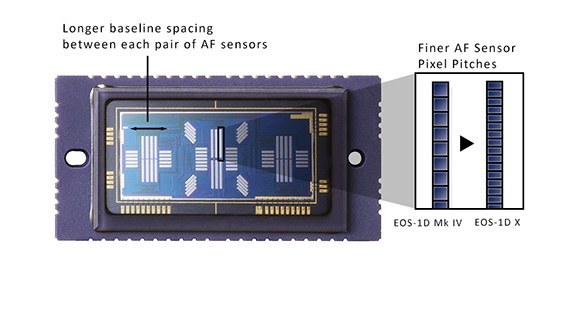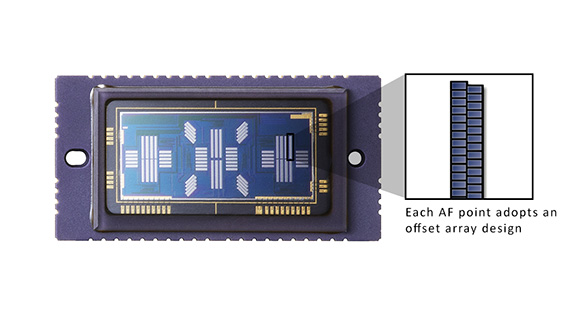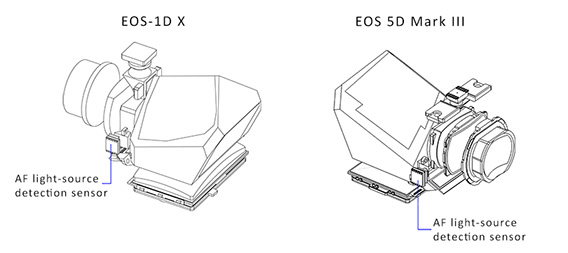Tag: EOS-1D X, EOS-1D C, EOS 5D Mark III, Autofocus, 61-point AF
The 61-point high density reticular AF sensor found in EOS-1D X, EOS-1D C and EOS 5D Mark III is an answer to demands from professional photographers on auto focus. Canon engineers have worked to increase the number of AF points, including more cross-type points, expand coverage and enhance precision, as we aim to get as close as possible to the performance of the human eye. The result is an AF sensor with 61 AF points, a significance increase from 45 points found in previous EOS-1D series, in which up to 41 points function as high precision cross-type AF points. In addition, a host of focus precision enhancing designs is incorporated in this AF sensor to further improve auto focus performance.
High-density AF points
The coverage of auto focus area in the 61-point high density reticular AF sensor has been increased from 8x15mm found in the 45-point AREA AF senor to 8x19mm. The wider distribution of AF points improves the level of freedom in composition even for off center subjects. Thanks to the arrangement of 61 AF points in a dense concentration, AI Servo AF tracking performance of quick moving subjects is also enhanced.

The coverage of auto focus area in the 61-point high density reticular AF sensor vs. 45-point AREA AF senor
Higher focusing precision for all AF points
Focusing precision has been improved for all AF points, which support apertures of f/2.8, f/4 and f/5.6. The f/2.8 sensors boast higher accuracy than their predecessors, while the f/4 sensors have the same high precision as EOS-1D Mark IV’s f/2.8 sensors, nevertheless the focus precision of f/5.6 sensors has also been increased. This was achieved by introducing advanced semi-conductor manufacturing processes for AF sensors to allow a finer pixel pitch. Longer baseline spacing between each pair of AF sensors also increases sensor sensitivity.
Another important factor in improving focusing performance is the use of cross-type sensors. The 61-point AF sensor supports up to 41-point widely-spread cross type AF sensors for f/4 lenses and 21-point cross type AF sensors at center even for f/5.6 lenses, realizing high auto focus performance for almost all lenses.
The advanced semi-conductor manufacturing processes also allow the AF sensor to focus in even lower light levels. Using single-point AF with an f/2.8 lens, the center AF point is able to focus in EV -2, which is the equivalent of shooting under the light of the full moon. This allows autofocusing even when shooting in dark conditions at high ISO speeds.

Conceptual diagram of higher focusing precision design
Reliable low-contrast focusin
Increasing the AF sensor sensitivity is not possible by simply increasing the density of AF sensor, the signal noise brought by the increased density will hinder the AF accuracy. In light of this, two line sensors are placed within each AF point and are arranged in an offset array with the pixel position staggered. Measuring results from the two line sensors, side by side, are averaged so they complement one another, minimizing detection errors that might otherwise occur with only single-line sampling. This ensures high-precision measurement. Low-contrast subjects, which are generally difficult for autofocus, are now easier to focus on. The 61-point high density reticular AF sensor uses dual-line sensors for all AF points, enabling high focus accuracy regardless of the composition. In both One-Shot AF and AI Servo AF modes, dual-line focusing is always used for Single-Point AF and Single-Point Spot AF.

Conceptual diagram of offset array in each AF points
Light Source Detection
The 61-point AF system features a light source detection system to improve focus accuracy under artificial lighting. Because of the higher resolution of the 61-point high density reticular AF sensor, chromatic aberration within the optics could lead to focus errors because the different colors of light waves are focused at slightly different distances. However, because the light source detection system is able to determine how much red/green or blue/green light there is in a scene with the AF light-source detection sensor and metering sensor, the AF system can adjust for any potential chromatic aberrations that may occur within the AF system. While this is useful in all shooting situations, the greatest benefit will be seen when shooting under artificial lighting.

AF light-source detection sensor is located next to the prism.
AF unit withstands high and low temperatures and high humidity
In 61-point AF system, the AF unit’s structure and materials were determined with consideration to environmental factors. The unit’s box-shaped structure is designed to withstand high temperatures, high humidity, extremely low temperatures, and impacts.
In case of EOS-1D X and EOS-1D C, the secondary imaging lenses, which have an influence over image reliability, are molded glass. They enable highly accurate and stable focusing as they suffer little distortion when exposed to extreme temperature and humidity. This highlights the superb reliability of 1D series cameras.

EOS-1D X AF Unit

